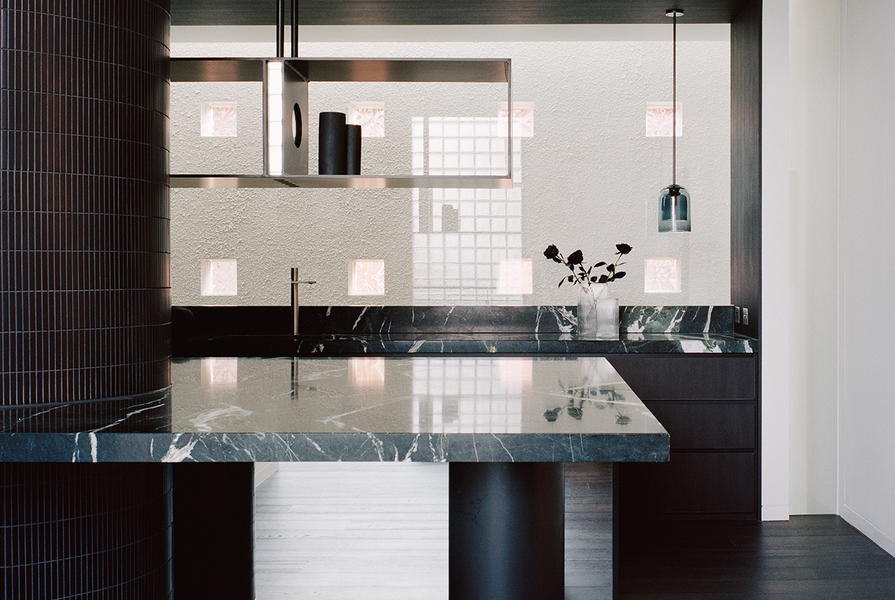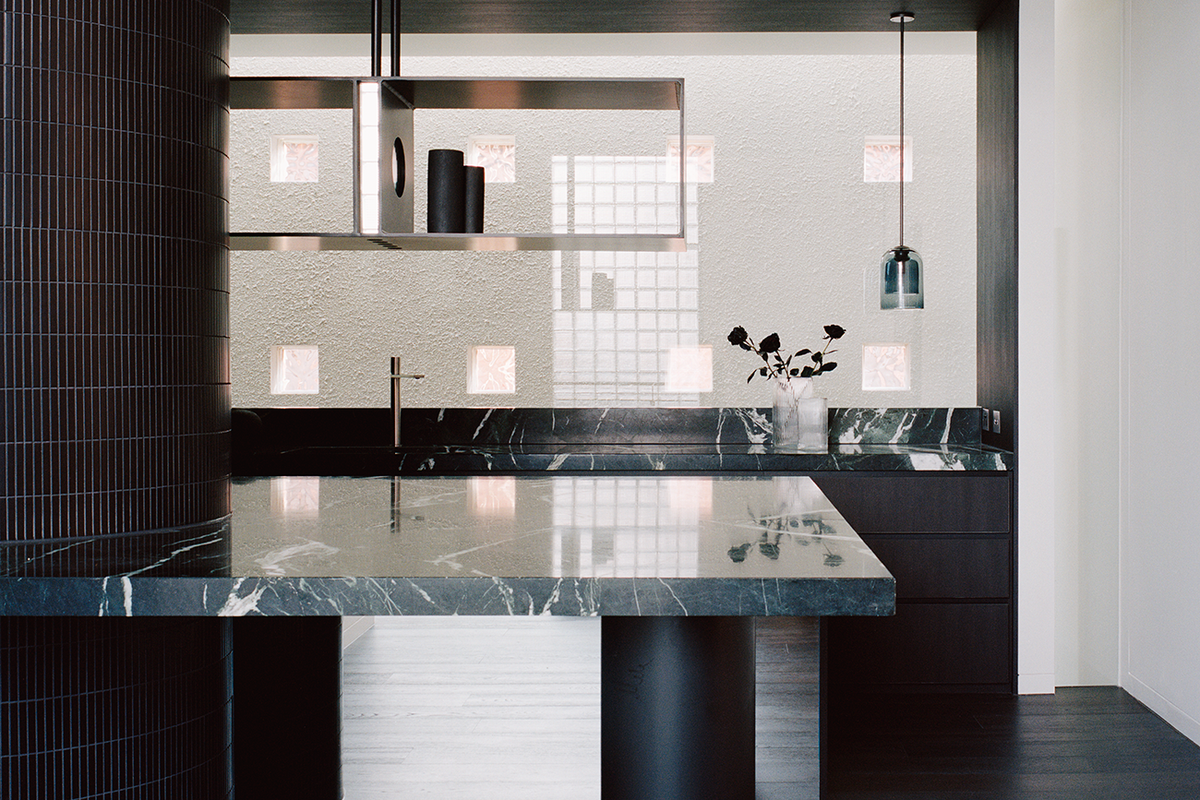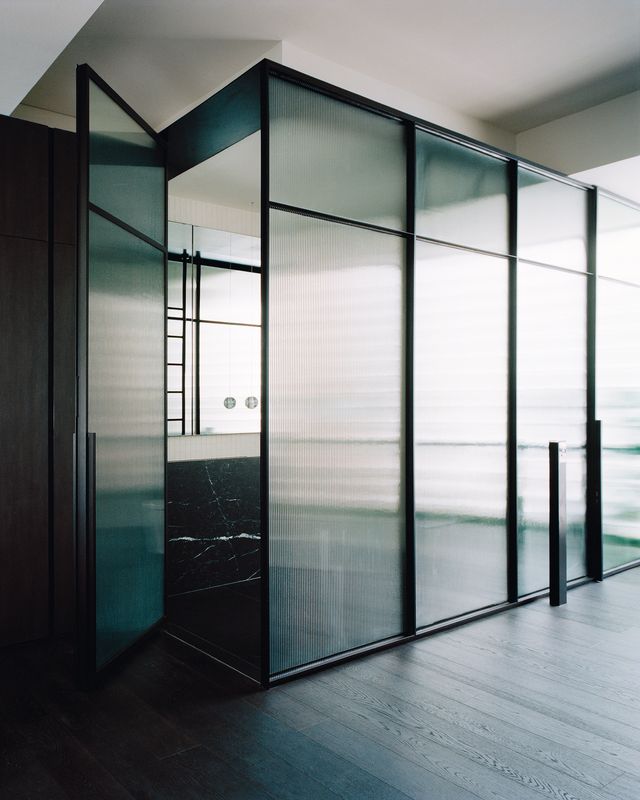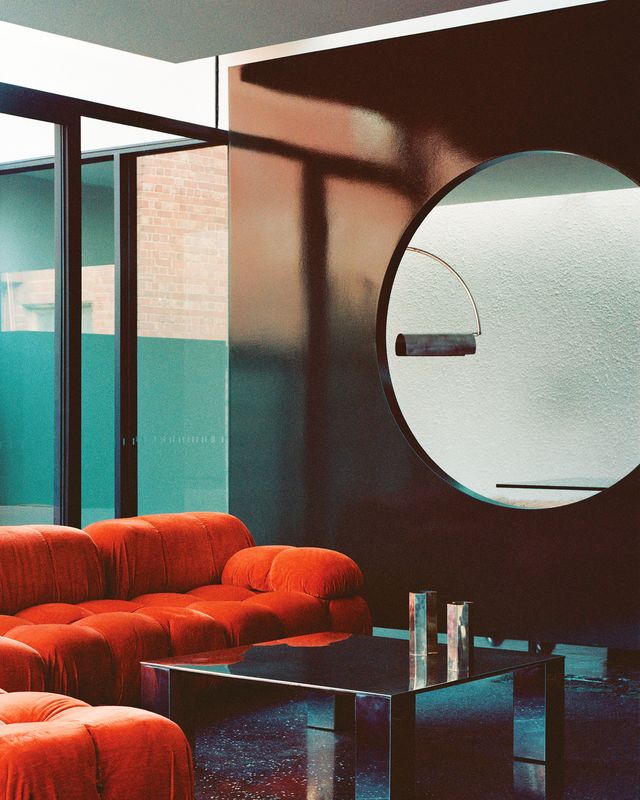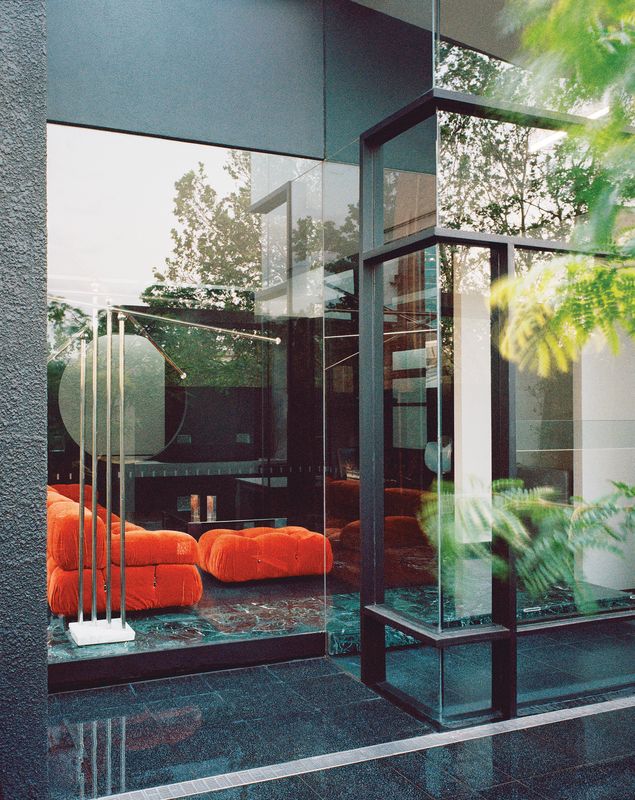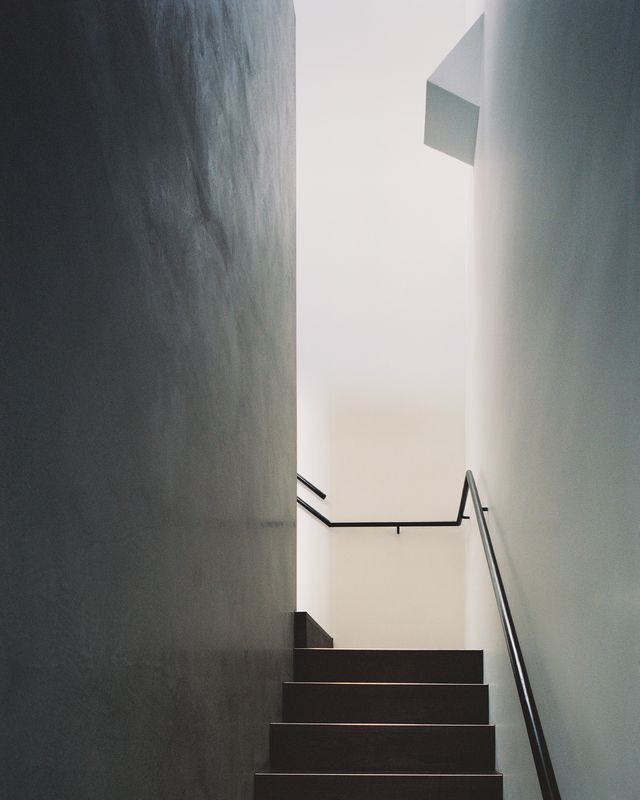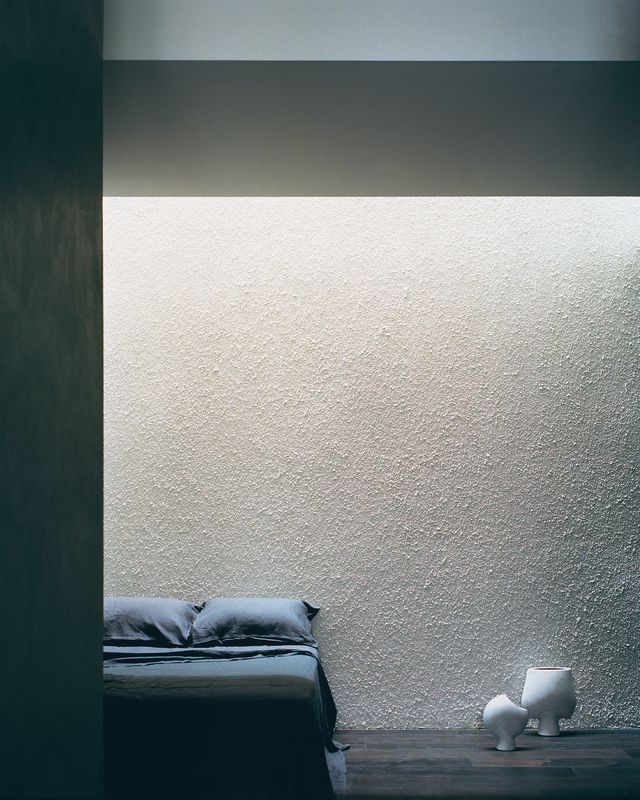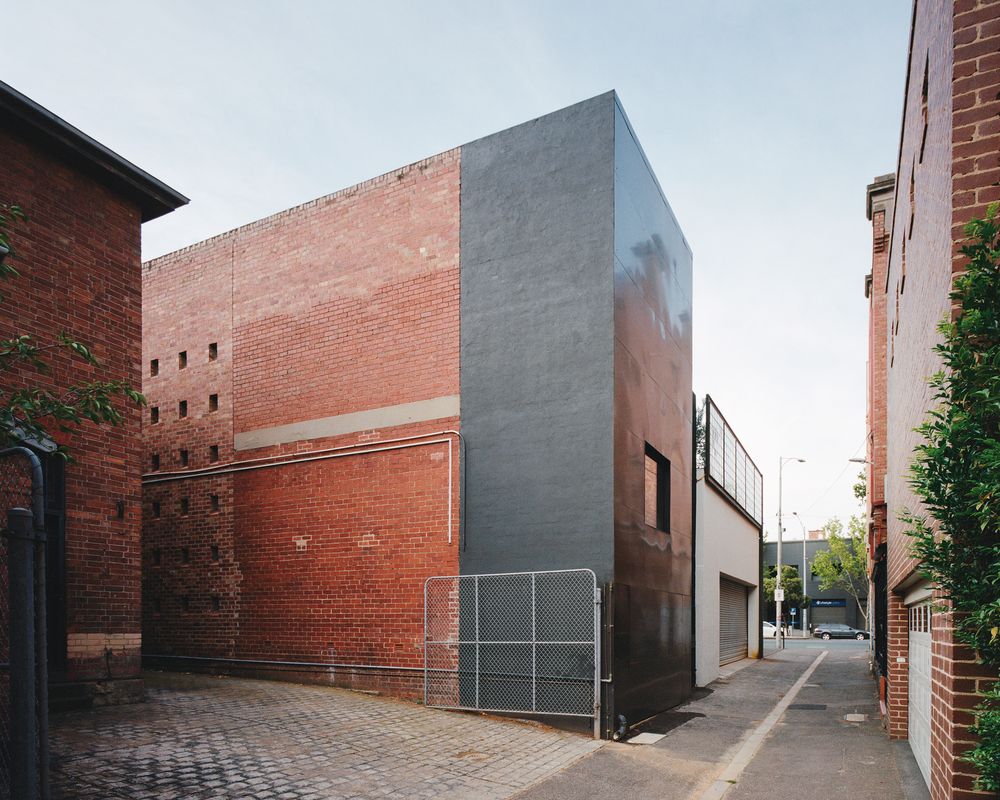Eastop Architects is a Melbourne-based practice led by architects Liam Eastop and Lauren Trainor, established in 2017. Despite the studio’s youth, it has produced in Elm Tree Place a work of considerable maturity, nuance and, literally and figuratively, reflection.
Elm Tree Place is a residence that converts an early adaptation project by celebrated architect Nonda Katsalidis, the Deutscher Fine Art Gallery in Carlton, Melbourne. Katsalidis’s project, completed in the 1980s, was a gallery space built at the rear of a Victorian terrace and Eastop Architects’ work splits that commercial property into two private dwellings. Stepping into such fertile terrain could have elicited a range of responses that either stepped away from the precedent entirely or paid overt reverence to what has gone before. Eastop Architects has taken a third way, forging an entirely new and confident residence out of the elemental remnants and clues left behind by the original design intent. The new residence does not fight against the period details but rather engages with them and, indeed, goes further to create something complete in and of itself. The phrase “leaning in” springs to mind.
A glass block screen flanks the courtyard that mediates between the two residences that occupy the site.
Image: Rory Gardiner
The design is resolved as a series of moments or tableaux, each of which is defined by a corresponding assemblage of materials and “elements,” as Liam puts it. The material palette throughout the house takes its cues from the black Nero Marquina marble used by Katsalidis. The tone is dark and moody; deep shadows are combined with crisp moments of glass block, mirrored surfaces and fluted glass screens framed in steel. On some walls, a sensuous rough stucco contrasts with these slick and reflective materials, and light enters opportunistically to lend lustre to the dark surfaces.
The entry and part of the facade is clad in an oiled steel that is just beginning to show a patina. Beyond the entry, a complex, high-ceilinged space of concrete, fluted glass and steel frames a series of potential pathways through the house. One can continue forward toward the main bedroom area, around the fluted glass screen and up to a mezzanine bedroom or up the stair near the main bedroom to the living level.
Deep shadow is juxtaposed with crisp moments of glass block, mirrored surfaces and fluted glass screens.
Image: Rory Gardiner
At this lower level, near the main bedroom, is a carefully detailed glass block screen that continues up through the building to the upper level. This screen flanks the courtyard that mediates between the two residences that occupy the site, the Victorian-era house at the front and Elm Tree Place behind it. The double garage of the front residence occupies part of the rear of the site and the movement of the neighbours from garage to house can be glimpsed through the glass block wall.
The mezzanine bedroom occupies the part of the over-scaled height above the single garage. The garage itself is memorable for its rear pivot doors, which conceal storage and a water tank. The doors’ mirrored face is evidence that no space within this densely designed house has been left without the designer’s attention. Eastop Architects worked closely with Patrizia and Ugo from Castorina and Co. to select furniture that both balanced and accentuated the interior spaces. In an approach similar to that of the architecture, pieces were selected for their varied formality, softness, and reflective and sculptural form. The mezzanine bedroom, which has its own private stair access, is a retreat in its own right, with an ensuite and single window onto the laneway.
Light enters the dwelling opportunistically, lending moments of sparkle to dark surfaces.
Image: Rory Gardiner
The first floor holds the kitchen, the living room, the dining room and a new marble-clad triangular powder room that has been added to the western end of the dining area. On this level, Liam and Lauren sought to maintain the “glasshouse” footprint of Katsalidis’s building, reasoning that alteration was not necessary and would have been an imposition on the budget without real justification. Changes have been made internally in the joinery and surfaces, and externally on the terrace with the removal (or, more correctly, the covering over) of the previously installed swimming pool.
The first-floor space, like the rest of the residence, is an assemblage of subtle shifts and elements. Level changes and punched-through openings allow for interesting views through the interior; the arrangement of spaces is not straightforward. This condition was inherited by Eastop Architects and the practice has again leaned into these details to exaggerate the effects created.
The complex spatial arrangement of the existing building has been skilfully optimized in the new design.
Image: Rory Gardiner
Given the complexity of the existing conditions and the age of the building, this project could have encountered logistical or technical problems that would have delayed the construction process. The main victims, had such a circumstance eventuated, would have been time and hence budget. That these problems did not occur is a testament to the skill of this young practice, and Liam and Lauren’s command of detail and technical complexity. While avoiding the pitfalls of complex renovation, Eastop Architects has simultaneously manifested a holistic piece of design that is mature, subtle and nuanced, and that contains a sense of inevitability and sophistication in its resolution. This is quite an achievement.
Products and materials
- Roofing
- Lysaght Trimdeck in Zincalume steel
- External walls
- Mild steel; concrete; Webforge aluminium grating in Dulux Electro ‘Black Ace’ powdercoat
- Internal walls
- Custom render; Venetian plaster; narrow-reeded glass; concrete; plaster
- Windows
- The Glass Block Shop Quadrillee glass blocks; custom steel windows in Dulux Electro ‘Black Ace’ powdercoat; timber windows in Dulux ‘Black’ paint finish
- Doors
- Custom steel-framed, narrow-reeded glass doors in Dulux Electro ‘Black Ace’ powdercoat; custom door in Woodcut Moss European oak floor cladding
- Flooring
- Woodcut Moss European oak flooring; Maximum Moon pressed-porcelain tiles from Artedomus; Signorino EM-1090 terrazzo tiles
- Lighting
- Articolo Lumi pendant; Ross Gardam Nebulae pendant; Delta Light lights from Inlite
- Kitchen
- Miele oven, stovetop and rangehood; Fisher and Paykel fridge; marble benchtop in ‘Vermont Green’ from Apex Stone; custom steel joinery in Dulux Electro ‘Black Ace’ powdercoat; NAV Navurban timber veneer in ‘Ravenswood’; Fantini tapware from Rogerseller
- Bathroom
- Custom vanity in Apex Stone ‘Nero Marquina’; Fantini Milano basin mixer, showerhead and shower mixer, and toilet suite, from Rogerseller
- Heating and cooling
- Fujitsu ducted airconditioning
- External elements
- Wolf barbecue; Signorino EM-1090 terrazzo tiles
- Other
- Furnishings from Castorina and Co.
Credits
- Project
- Elm Tree House by Eastop Architects
- Architect
-
Eastop Architects
- Project Team
- Liam Eastop, Lauren Trainor, Louis O’Connor, Klara Fletcher
- Consultants
-
Builder
CBD Contracting Group
Engineer DCG
Furniture Castorina and Co.
Landscape design Eckersley Garden Architecture
- Aboriginal Nation
- Elm Tree House is built on the land of the Wurundjeri people of the Kulin nation
- Site Details
-
Location
Melbourne,
Vic,
Australia
Site type Urban
Site area 535 m2
Building area 205 m2
- Project Details
-
Status
Built
Completion date 2019
Design, documentation 12 months
Construction 12 months
Category Residential
Type Alts and adds
Source
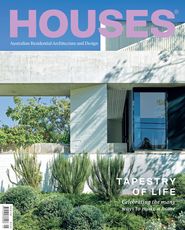
Project
Published online: 24 Sep 2021
Words:
Marcus Baumgart
Images:
Rory Gardiner
Issue
Houses, October 2020

